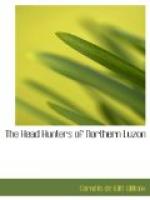It is astonishing that these people should not have evolved a better house, seeing that the Ifugaos have done it, and the Kalinga houses, which we were to see in a day or two, are really superior affairs.
Passing by a certain house, Father Clapp stopped and said, “Here is where Pitapit was born,” and stood expectant. Strong and I looked furtively at each other; it was evident that we were supposed to know who Pitapit was. But as we did not, the question was put: “Who is Pitapit?” Father Clapp, gazing pityingly upon us, as though we had asked who George Washington was, then enlightened us. Pitapit is a Bontok boy of great natural qualities, so great, indeed, that he was sent to the States to a church school, where he had recently won a Greek prize in competition! Father Clapp was naturally very proud of this, as he well might be. The fact of the matter is that Igorot children are undeniably bright; given the chance, they will accomplish something. And I repeat what I have said before: we are trying to give them and their people a chance, the only one they have ever had.
We remarked, as we walked about this morning, that although Father Clapp seemed to know some of the people we met and would speak to them, they never returned his greeting. None of these highlanders have any words or custom of salutation. In the Ifugao country, however, they shake hands, and would frequently smile when on meeting them we would say, “Mapud!”—i.e., “Good!”—the nearest thing to a greeting that our very scanty stock of Ifugao words afforded. But the Igorot never shook hands with us nor offered to: they have no smile for the stranger, though they seem good-humored enough among themselves.




